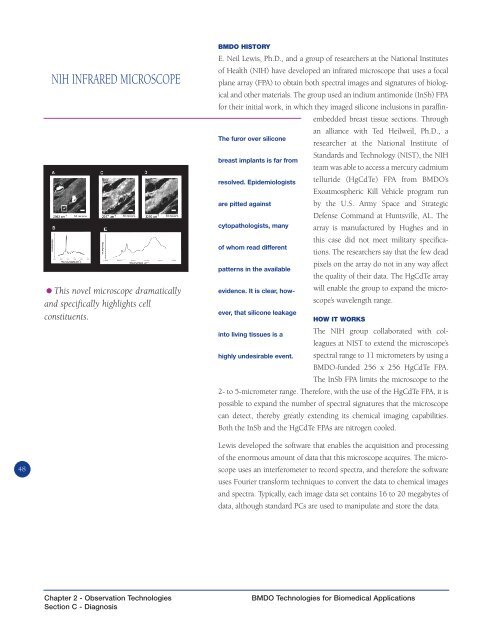bmdo technologies for biomedical applications - MDA Technology
bmdo technologies for biomedical applications - MDA Technology
bmdo technologies for biomedical applications - MDA Technology
You also want an ePaper? Increase the reach of your titles
YUMPU automatically turns print PDFs into web optimized ePapers that Google loves.
NIH INFRARED MICROSCOPE• This novel microscope dramaticallyand specifically highlights cellconstituents.BMDO HISTORYE. Neil Lewis, Ph.D., and a group of researchers at the National Institutesof Health (NIH) have developed an infrared microscope that uses a focalplane array (FPA) to obtain both spectral images and signatures of biologicaland other materials. The group used an indium antimonide (InSb) FPA<strong>for</strong> their initial work, in which they imaged silicone inclusions in paraffinembeddedbreast tissue sections. Throughan alliance with Ted Heilweil, Ph.D., aThe furor over siliconeresearcher at the National Institute ofStandards and <strong>Technology</strong> (NIST), the NIHbreast implants is far fromteam was able to access a mercury cadmiumresolved. Epidemiologists telluride (HgCdTe) FPA from BMDO’sExoatmospheric Kill Vehicle program runare pitted againstby the U.S. Army Space and StrategicDefense Command at Huntsville, AL. Thecytopathologists, many array is manufactured by Hughes and inthis case did not meet military specifications.The researchers say that the few deadof whom read differentpixels on the array do not in any way affectpatterns in the availablethe quality of their data. The HgCdTe arrayevidence. It is clear, however,that silicone leakagewill enable the group to expand the microscope’swavelength range.HOW IT WORKSinto living tissues is a The NIH group collaborated with colleaguesat NIST to extend the microscope’shighly undesirable event. spectral range to 11 micrometers by using aBMDO-funded 256 x 256 HgCdTe FPA.The InSb FPA limits the microscope to the2- to 5-micrometer range. There<strong>for</strong>e, with the use of the HgCdTe FPA, it ispossible to expand the number of spectral signatures that the microscopecan detect, thereby greatly extending its chemical imaging capabilities.Both the InSb and the HgCdTe FPAs are nitrogen cooled.48Lewis developed the software that enables the acquisition and processingof the enormous amount of data that this microscope acquires. The microscopeuses an interferometer to record spectra, and there<strong>for</strong>e the softwareuses Fourier trans<strong>for</strong>m techniques to convert the data to chemical imagesand spectra. Typically, each image data set contains 16 to 20 megabytes ofdata, although standard PCs are used to manipulate and store the data.Chapter 2 - Observation TechnologiesSection C - DiagnosisBMDO Technologies <strong>for</strong> Biomedical Applications




